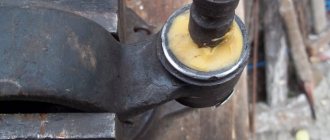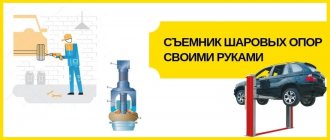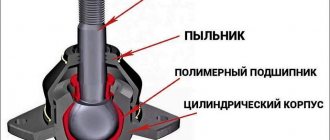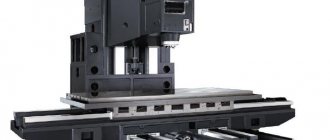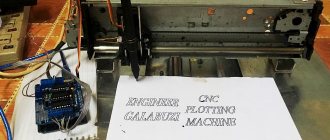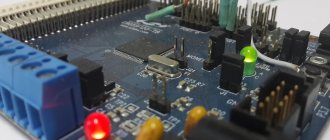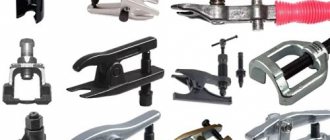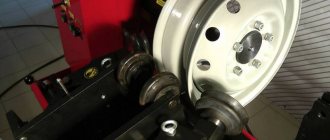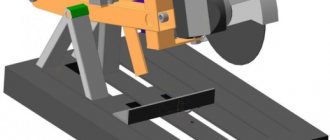Do-it-yourself machine for restoring ball joints - Metalworker's Guide
Every owner of his own car dreams of saving on its maintenance. Replacing ball joints is one of the expense items, especially taking into account our roads.
And if the suspension design involves simultaneous replacement of the ball and lever, the question becomes a pretty penny.
To help drivers, SJR technology was invented - restoration (repair) of ball joints with polymer.
Why is ball joint repair necessary?
The suspension arms hold the steering knuckle with the hub using ball joints. This is actually the steering axis of the wheel. The unit experiences loads from all sides and wears out quite quickly on uneven roads.
Play in the ball joint leads to loose suspension, and, more dangerously, to inaccuracy in the steering. Critical wear can lead to the destruction of the support - and then the car’s wheel will simply fall off.
Probably many have observed a similar picture.
Of course, the wheel does not always fall over, especially on foreign cars, but VAZs suffer from this
It’s good if this happens on an unloaded road and at low speed. What if it’s on the highway and high? The consequences can be dire. Therefore, when minimal play appears, you should try to determine possible malfunctions of the ball joints.
Polymer restoration using SJR technology
Did the diagnostics reveal a dangerous gap between the ball and the support liner? A dilemma arises: change or restore. Let us briefly describe the structure of the ball joint.
In the areas marked in red, wear is maximum
The unit consists of two parts, a cage and a rotating ball. Between them is a polymer that dampens hard impacts and reduces friction between metal parts. The system works on the principle of a joint capsule in the human legs. It is this polymer that wears out over time, and dangerous play appears.
Since it is impossible to disassemble the ball joint to replace the liner, there is only one thing left to do - melt the polymer and pour it inside. This is the essence of the sjr method.
Pouring polymers can be of different types
- A hole is made in the outer casing (clip) of the ball joint. You can use a ready-made grease fitting, if available.
- Using a gas burner, the ball joint is heated to the melting point of the polyamide.
- At the same time, blanks (cartridges) made of polyamide, similar to the standard one, are heated in a special extruder.
- Using an extruder under high pressure, the melt is injected into the cavity between the holder and the moving ball. Moreover, all the cracks, crevices and hollows of the standard liner are filled.
- The polymer hardens, taking the shape of the gap. The play has been eliminated, the ball joint has been restored.
Advantages of this method:
- Versatility and affordability.
- Compactness and mobility of equipment.
- Can be used both in a small service station and in your own garage.
- Available consumables.
There are also methods using stationary equipment. The repair technology is close to the factory one used in the manufacture of new ball joints. The cost of repair is approaching the price of a new unit, which makes the process unprofitable.
What is needed for the work
The economy class set is shown in the photo:
The cost of the kit will be recouped only after a while. Rarely does anyone buy it at once - it’s unprofitable
- The most important part of the kit is the extruder. It heats up and forms the consistency of polyamide.
- Transition fittings, with the help of which the melt is poured under pressure into the ball joint.
- A gas torch or a hair dryer to heat up the ball joint (if this is not done, the polymer will harden when pouring, and there will not be 100% filling).
- Remote thermometer to control heating.
- An air compressor that creates pressurized air for the extruder.
A more advanced version has a piston that creates pressure for the extruder without the use of compressed air.
As you can see, there are also many types of equipment
There is no need to buy a compressor, but the kit itself is more expensive. But you can control the heating temperature using your own thermometer (again, there is no need to purchase one). A gas torch or hair dryer is still needed to warm up the ball joint before filling.
Important! The mobile kit allows you to perform work directly under the bottom of the car without removing the ball joint.
However, this is not recommended, since local heating using a burner is impossible, and there is a danger of damaging the brake hoses or rubber boots.
Therefore, do not be lazy to dismantle the ball joint and carry out the work on a workbench.
The workbench will provide convenience and safety
Making an extruder with your own hands: details about the complex
If you have a home locksmith workshop, you can make the device yourself; in extreme cases, you should use the services of a turner.
- It is necessary to make a tightly fitted piston and cylinder.
Diameter 10–15 cm, length 20–30 cm. The part should not be too bulky - O-rings can be made of rubber, but in most cases a thick grease will suffice.
Make O-rings from quality rubber - A fitting for supplying compressed air is connected to the cylinder on the blind side.
It is equipped with a ball valve. Hook up the air injection fitting - An adapter is screwed into the open part of the air cylinder.
It is equipped with a lock for fixing the cylinder in which the polymer is heated. Equip the device with an adapter - The polymer cylinder is smaller.
Due to the difference in diameters, the pressure when pressing the polymer is higher than that supplied from the compressor. Pay attention to the proportions of the polymer barrel and the extruder body itself
An extruder is sometimes called a remanufacturing machine or stand.
Restoring balls using a homemade extruder
Once the extruder is assembled, you simply load the polymer cartridge into the barrel and connect it to the prepared hole in the ball joint.
While simultaneously heating the ball body and the cylinder with polyamide, you shake the ball pin for uniform penetration of the melt. Once the air cylinder in the extruder stops, the process is considered complete.
Allow the polymer to harden inside the part, and you can install the ball joint on the car.
Filling balls on a Toyota Corolla: video
There is no need to remove the polyamide from the cylinder after work. It will melt again when the next part is restored.
By making such a device, you will not only be able to save on suspension maintenance, but also earn money by providing similar services to friends. The cost of purchasing components for the extruder is recouped after rebuilding a pair of ball joints.
Ball joint restoration machine
» Machine » Machine for restoring ball joints
Ball joints prevent the vehicle's front wheels from turning outward, keeping them upright. The supports constantly withstand enormous loads, so they have to be changed quite often.
Moreover, for some models, they can only be replaced together with the control lever, and this is an expensive and complicated procedure.
There is a technology for restoring supports that saves money for car owners and even machines that craftsmen make with their own hands.
Ball joint device
The ball joint is the front suspension element that bears the main load. It can be lower or upper. The main part is a finger with a round head. The head is enclosed in a dirt-proof cover with lubricant.
The entire device is hidden in a plastic case, which over time begins to let dirt through. Getting between the head and the cover, sand and earth scratch the head and the protective shell of the cover.
Penetrating moisture causes rust.
Modern restoration technology allows you to repair the supports yourself, without disassembling the car.
Under pressure, a special type of molten polymer is injected into the housing of the support assembly.
Equipment for restoration and restoration of ball joints
Ball joints prevent the vehicle's front wheels from turning outward, keeping them upright. The supports constantly withstand enormous loads, so they have to be changed quite often. Moreover, for some models, they can only be replaced together with the control lever, and this is an expensive and complicated procedure. There is a technology for restoring supports that saves money for car owners and even machines that craftsmen make with their own hands.
Ball joint device
The ball joint is the front suspension element that bears the main load. It can be lower or upper. The main part is a finger with a round head. The head is enclosed in a dirt-proof cover with lubricant. The entire device is hidden in a plastic case, which over time begins to let dirt through. Getting between the head and the cover, sand and earth scratch the head and the protective shell of the cover. Penetrating moisture causes rust.
Modern restoration technology allows you to repair the supports yourself, without disassembling the car.
Under pressure, a special type of molten polymer is injected into the housing of the support assembly. All voids and cracks that appear in the body are filled with plastic, which creates an additional lens-shaped gasket in the required places. Restoration takes only 15 minutes, equipment based on American designs is used in most auto repair shops.
Ball joint restoration machine
The technology described above is implemented using a machine. It consists of:
- control unit with a display showing the current and final temperatures;
- extruder;
- 6 atm compressor;
- pneumatic cylinder;
- thermal pencil;
- set of injector adapters;
- polymer.
Additionally, you need to purchase a gas burner and plumbing tools.
Restoration of support
machine for restoring ball joints
An extruder, which already contains a polymer, is screwed onto the thread of the pneumatic cylinder. A threaded hole is drilled in the support body. Using this thread, a nozzle is screwed on, which is attached to the extruder through a nozzle.
As soon as the polymer becomes soft, it is necessary to start the pneumatic cylinder, squeezing the material through the plunger into the nozzle and then into the support cavity. The soft polymer fills all the potholes, gaps and cracks, creating a ball liner with increased resistance to impact. Even if the polymer is not poured quite correctly, the new liner can withstand about 30 thousand kilometers.
It is quite possible to assemble such equipment for restoration with your own hands. The extruder can be ordered from a turner. A brake chamber from a ZIL or an old cylinder from a clamshell excavator can be used as a pneumatic cylinder. All other spare parts are sold at any hardware store.
Disadvantages of DIY equipment
- When overheated, the polymer completely loses its properties, and in the presented homemade device it is heated by a burner; it is almost impossible to measure its temperature.
- The result of the work largely depends on the experience of the master; it is difficult without the skills to warm the material, support and carefully pour the polymer into the cavity.
In factory devices, heating occurs under electronic control, and the ball nozzle is attached without threads. However, many craftsmen achieve quite decent results using home-made equipment.
The video demonstrates the operation of a factory machine:
stanokgid.ru
Do-it-yourself extruder for restoring ball joints
The suspension arms hold the steering knuckle with the hub using ball joints. This is actually the steering axis of the wheel. The unit experiences loads from all sides and wears out quite quickly on uneven roads.
Play in the ball joint leads to loose suspension, and, more dangerously, to inaccuracy in the steering. Critical wear can lead to the destruction of the support - and then the car’s wheel will simply fall off.
Probably many have observed a similar picture.
Of course, the wheel does not always fall over, especially on foreign cars, but VAZs suffer from this
It’s good if this happens on an unloaded road and at low speed. What if it’s on the highway and high? The consequences can be dire. Therefore, when minimal play appears, you should try to determine possible malfunctions of the ball joints.
What to do if the ball joint breaks while driving
If the lower or upper support breaks down while the car is moving, complete loss of control over the car is possible. The degree of risk of getting into an accident is directly determined by the speed of the car, the prevailing conditions on the road at the time of the breakdown, as well as the actions of the driver.
You need to perform emergency braking and move the car closer to the side of the road. In this case, the broken wheel will pull the car in its direction, so the driver will need to make a lot of effort to maintain balance. If the car is at high speed when the ball joint fails, braking should be done carefully in order to avoid skidding, turning and overturning the car.
This can be avoided by following simple principles:
- Before you start driving, you need to make sure that the machine is in good working order.
- Use high quality auto parts. Savings are unacceptable. The low cost of a ball joint usually indicates low quality of the part.
- Timely maintenance without waiting for a complete breakdown.
About the device
If you didn’t click on the link above and didn’t read it, here I’ll remind you a little about the structure. You need to understand that the ball joint serves for a movable joint that can rotate, that is, movement in several planes at once. In cars it is mainly used in the front suspension to turn the front wheels.
- There is a cylindrical body.
- A polymer liner that is immersed in it.
- Metal finger or “ball” or rod, there are many names. On one side it has a spherical element, on the other side there is a threaded rod.
- The boot protects the structure from the penetration of dust and dirt.
- Pressure spring or even the bottom. By the way, sometimes it is not there if the support is not collapsible.
Just like that, but we need this in order to understand how to restore.
The ball joint is designed for reliable movable fastening of the wheel hub to the suspension arm. The ball joint consists of a ball pin, a housing and a plastic insert.
The body of the ball joint is either spot welded from two halves with stamped, spherical recesses with a hole for a finger in one of them, or it is a thick-walled metal cup into which an insert with a finger is inserted, after which the bottom is placed, and the edge is rolled so that the structure does not disassemble.
Sometimes the liner is not made, but the gap between the body and the ball is filled with softened polyamide plastic. An extruder is usually used for this. It is also used as the main equipment in companies for the restoration of ball joints. To protect the mating surfaces of the hinge from water and dirt, put a rubber boot on top.
As long as the boot is intact, the ball joint practically does not wear out. Intensive wear of the ball begins after the boot becomes unusable, with dirt getting inside. Therefore, keep an eye on the boots, since timely replacement of an unusable boot will extend the life of the unit.
Read more: If your name is Range Rover: test drive the Range Rover Velar
Restoring ball joints: repair using SJR technology and dismountable restoration method
Ball joints take on the weight of the front part of the vehicle, including the power plant. Also, during movement, this unit is exposed to constant shock load.
It is quite obvious that in such conditions the service life of the support is limited, even if it is made of the most durable alloys.
As a result, many car owners are faced with the need to restore ball joints.
The ball joint allows for a reliable movable connection between the wheel hub and the suspension arm. The assembly includes a housing, a ball pin , and an insert made of plastic. The body most often has a welded structure - two parts with a stamped spherical recess for the finger are connected using spot welding.
Essentially, this element is a thick-walled glass made of metal into which an insert with a finger is then inserted. To make the housing structure non-separable, its edges are flared.
Often the liner is not manufactured separately, but the area between the walls of the housing and the ball surface of the finger is filled with a special polymer material. To protect the unit from dirt and water, a boot is placed on top.
It should be noted that active wear of the ball joint begins after the boot is damaged . Until this happens, the unit is practically not subject to wear. Thus, if you monitor the condition of this element and replace it in a timely manner, you can significantly increase the life of the unit.
However, it is worth remembering that the weld joints do not have sufficient tightness and even with an intact boot, water can get inside. To avoid this, the case should be filled with lithol.
Node diagnostics
You can find out about the need for restoration work on ball joints through diagnostics.
As soon as you hear a creaking and knocking sound from the suspension while driving on an uneven road, the unit is worn out and needs to be restored.
To accurately determine the source of these sounds, it is better to carry out diagnostics together - one person enters the inspection hole and puts his hand on the ball joint, and the second begins to rock the car.
If the sound is felt by hand, then the support must be removed and checked for play in the hinge joint, securing it in a vice. It should be remembered that the finger should not move under the influence of light forces, but at the same time it should not bite. It is also recommended to carry out a similar check in the following situations:
- A squeaking sound is heard when turning the steering wheel.
- When driving in a straight line, the car spontaneously wobbles.
- To turn the steering wheel you have to apply quite a lot of force.
If after carrying out diagnostic measures it becomes clear that the unit is worn out, it must be repaired. Many novice car owners cope with all the work and restore the ball joints with their own hands. To remove and install the support after repair, you will need several tools:
- Special puller for supports.
- Car stand.
- Jack.
- Mount.
- Pliers.
- A set of keys.
Most often, ball joint pullers are not universal. If you cannot find the required tool, you can solve the problem using a hammer. Moreover, its weight should be about 600 grams. In addition, you need to know the place where you should strike so as not to damage the node.
There is no need to try to knock your finger out of the seat. The blow should be directed perpendicular to the finger along the eyelet. To remove the ball joint, you first need to loosen the front wheels and jack up the car. After this, the wheel is removed.
If the nut on the pin has a cotter pin, it should be removed using pliers. This will allow you to unscrew the nut and use a puller or hammer to squeeze out the pin. After this, you should unscrew the housing mount and, using a pry bar, press the lower lever to remove the support.
To install the unit after repair, you first need to attach the housing to the lower arm. After tightening the fasteners, use a pry bar to release the lever and return the pin to the socket.
Then the nut is screwed onto it and tightened. If after this the finger rotates, then the lower lever must be pulled up.
The last step will be to install the cotter pin on the nut or replace the old one with a self-locking one.
Repair work
It should be immediately noted that after the repair is completed, the ball joint will not be completely restored and its service life will be shorter. However, if everything was done correctly, then you don’t have to worry about the safety of the unit’s operation. There are several ways to restore the ball's functionality. At home, two technologies are most often used:
- Repair of ball joints with polymer using SJR technology.
- Collapsible - the body is converted from a non-separable one into a collapsible one, after which the ball surface of the pin is polished and the liners are changed.
Using polymer
The essence of this method is to inject heated polymer material into the housing. In this case, the support does not need to be disassembled, but an extruder must be manufactured. It is worth noting the main advantages of this method:
- Since the housing structure is not destroyed, high reliability of the factory connection is ensured.
- The polymer fills all the voids and wear-out areas that caused the support to fail.
- When the material hardens, it forms a solid liner, the characteristics of which are at least as good as the factory part, and sometimes even superior.
- The polymer contains special ingredients that provide high-quality dry lubrication of the finger.
- High strength under impact loads is achieved.
To use this technology, a hole must be drilled in the lower part of the body, the diameter of which is selected in accordance with the extruder used. It is necessary to thoroughly clean the gap between the liners and the ball surface of the pin from dirt, and also blow the assembly with air to remove chips and grains of sand.
The polymer is injected into the housing using an extruder through a pre-drilled hole. Once the plastic composition has hardened, the repair work can be considered complete. The only drawback of this technology is the inability to check the geometry of the spherical surface of the finger.
Collapsible method
After the support is removed, it is necessary to disassemble the housing. To do this, you will need to drill out all the welding points in one half, then divide the part into two parts using a hammer and chisel.
Then the flared edges are ground down and a blow is applied to the end of the pin to separate the bottom of the body.
After measuring the inner and outer diameters of the body, a ring with similar dimensions and internal threads is made, as well as a plug that is screwed into this part. The height of the ring should be about 10 cm.
After this, a new liner and the restored finger are placed in the body. Having connected the two parts of the body, they should be secured by welding. Care must be taken to avoid overheating the liner.
Then the previously made ring must be welded to the body. After this, all that remains is to screw the plug into the body to tighten the liner and drill a small hole in it (diameter about 2 mm) for the cotter pin.
Equipment for repairing ball joints using SJR technology — obd2scan.ru on DRIVE2
The In-Place Ball Joint Repair (Ball Joint Remanufacturing) system has been designed to rebuild the front suspension and steering of all types of vehicles to maintain tr. The device is in working order and easily manageable. The use of the system can be considered an innovative, cost-effective method for vehicle owners in carrying out a maintenance program, and this method is transferred from passenger cars to heavy-duty vehicles, military vehicles, all-terrain vehicles, etc.
This system was developed, copyrighted and distributed in the USA. This system allows the mechanic to restore almost all tie rods, ends, ball joints, links, etc., included in the steering and front suspension systems of large and small vehicles and can be used in almost all auto repair shops to restore parts that are not completely worn out .
A special polymer is injected into the assembly, which is supplied in the form of ready-made rods and which is formulated to withstand high pressure (compressive force up to 18,000 ft per 1 sq. in. (1,300 kg/sq. cm.), approximately 130 MPa and torsion 12,000 feet per square inch). This material is designed to absorb dynamic impact and friction, is not affected by lubrication, and guarantees a range of up to 100,000 km. in the USA (for passenger cars) or 6 months. guarantees subject to complete suspension repair in Russia.
The molten polymer is injected into the assembly through the lubrication hole (if there is none, the hole is drilled and a thread is cut for the fitting) under high pressure (100 atm.) using a special device. After injection, the polymer becomes an ideal liner with high compression ability, lubricating properties, and also absorbs friction. Repairs can be made on the same unit more than once. After restoration, the quality of the unit is comparable to the original spare part.
Restoring ball joints using the SJR system is a great addition to the services of your car service!
The delivery set includes: 1 Extruder (machine) 2 Adapters 3 pcs. 3 Pressure regulator 4 Pyrometer 5 Polymer 10 pcs.
6 Blow gun
Additionally, to get started you will need: - Pneumatic compressor (pressure 8-10 atm, performance does not matter - extruder volume is about 1 liter); - Gas burner or hot air gun (heating temperature 180-200 degrees C); - Equipment for drilling holes and thread cutting M6 (required for some ball joints) You can purchase equipment for repairing ball joints in Krasnodar at the address: st. Hakurate 12, office 05.
Or order with delivery by a transport company in Russia on the website www.obd2scan.ru
Consumable polymers are always in stock.
www.drive2.ru
Do-it-yourself device for restoring ball joints - Metals, equipment, instructions
The suspension arm is connected to the center of the wheel (hub) using a ball joint. Symptoms of failure of this unit are: knocking while driving over bumps, “swaying” of the car on a flat road, uneven wear of the tires and creaking when turning the steering wheel all the way. For what reasons can a ball joint fail?
Causes of ball joint wear
The main enemies of the ball have always been water and dirt. They can get to the joints only if the boot wears out - a rubber cover that protects the hinge from external influences. It either wears out during operation (dries out, cracks), or can be damaged mechanically (for example, during suspension repairs).
The service life of the ball joint varies from 15 thousand km to 120. The indicator depends on the operating conditions of the car and the condition of the protective boot.
Self-diagnosis
The best option to find a fault is always a diagnostic stand at a service station. But it is also possible to find the breakdown yourself. To determine the malfunction of the ball joint by ear, you will need an assistant who will rock the car from side to side, while the owner himself carefully listens to all the creaks and knocks that the suspension makes.
Checking the condition of the ball joints visually is much more effective, but you will need an inspection hole or a lift. The assistant holds the brake pedal, and the owner rocks the wheel. If there is play, then the ball joint must be changed or, in order to save money, try to restore it.
Repair and restoration of the ball joint
The ball joint can be either collapsible (for example, in domestic cars) or non-dismountable. Of course, it is much easier to repair a unit that can be disassembled for spare parts. The ball is dismantled, disassembled and worn parts are replaced. As a rule, these are polymer inserts and anther. Then install the unit in place. The repair of ball joints (dismountable) is completed.
If the ball cannot be disassembled, then either a grinder is used to make the support collapsible, but after repair the structure is restored by welding, or they use a more humane method and pour liquid polymer into the ball under pressure.
Many people recommend disassembling the support in any case to grind the axle ball or replace it.
How to disassemble something that cannot be disassembled
Before disassembling the ball joint, it must be removed. For this:
- We jack up the car and remove the wheel.
- Turn the steering wheel all the way.
- Remove the cotter pin from the nut using pliers.
- Unscrew the nut and use a puller to squeeze out the axle.
- Unscrew the ball mount.
- Using a pry bar, press the lower lever, and you can remove the ball.
Now you need to disassemble the support. If it consists of two welded cups, then you need to drill several welding points on one of them, and then use a chisel to separate these cups. Then a finger with an insert is inserted into the body, and the cup halves are welded together. It is worth making sure that this liner does not overheat.
If the body has an inserted bottom, then the flared edges are cleaned with a grinder or emery cloth. Then they hit the end of the axle with a hammer to knock out the bottom.
The outer and inner diameters of the body are measured and a steel ring 10 mm high with thread and plug is made. It is welded to the support body. Insert the finger with the liner and screw in the plug so that it presses the liner.
A 2 mm hole is drilled in the ring as close as possible to the plug and it is secured with a cotter pin.
To install the ball joint in place, you must:
- Attach the ball to the lower arm and secure it.
- Install the pin (axle) into the seat, while pressing the lower lever.
- Tighten the nut onto the pin.
- If the finger rotates at the landing site, use a pry bar to pull the lever up.
When installing the support in place, you will not need a puller. It will be easier to remove and install the ball again if you replace the cotter pin with self-locking nuts.
Liquid polymer application method
Ready-made rods filled with liquid polymer are available for sale to restore ball joints with your own hands. The polymer composition is specially designed for components with increased load.
It withstands pressure over 1000 kg/cm2 and dampens friction. Not affected by lubricants. Ensures the restoration of the ball joint and its operation for another 100,000 km.
This repair method can be used several times.
The technology of this method is quite simple. Using an extruder with pneumatic force, the polymer is injected through a special hole into the assembly body. It fills the voids inside, completely follows the contour of the support pin and takes on all the loads.
Ball joint repair machine
To correctly perform work on restoring the ball joint, you must use a machine. It is designed to measure the temperature of the polymer and correctly feed it into the ball housing.
A standard machine for restoring ball joints consists of:
- from the control unit;
- extruder;
- compressor;
- pneumatic cylinder;
- thermal pencil;
- several adapter nozzles;
- polymer.
The extruder with the polymer inside is screwed to a pneumatic cylinder. A threaded hole is made in the worn support and an adapter nozzle of the required size is inserted into it, which is connected to the extruder with a nozzle.
After the polymer material becomes soft, a pneumatic cylinder is launched, which squeezes it through the plunger and nozzle into the support. If the material is filled incorrectly, the ball will last about 30,000 km.
It is worth considering that overheating a polymer material deprives it of all its necessary properties. Therefore, you should carefully read the instructions supplied with it and monitor the temperature according to the machine readings.
You can construct equipment for restoring ball joints yourself: make an extruder on a lathe, and buy the remaining parts at a hardware store.
The only reason why this technology cannot be used is corrosion and mechanical damage to the metal structure itself. In this case, the ball joint is not subject to any restoration and, accordingly, to further use.
Restoring the ball joint. Including liquid polymer, we repair it ourselves
I already wrote about the design of the ball joint, you can read it here . In that article, I briefly touched on the problem of repair, but many of my readers began to write - is it possible to restore it yourself.
At first I thought that this was not the right saving, but after understanding the problem, it turns out that sometimes it is much more profitable to repair.
Once again I emphasize much! The thing is that the supports are currently installed in the levers and cannot be removed! This is not the same structure as it used to be on our VAZs...
That is, the ball joint used to be removed in 95% of cases, it was physically unscrewed from the suspension arm (in our VAZs they were called “burdocks”), and in many foreign cars of the 90s - 2000s they were often removable. Now many manufacturers weld supports into the lever or into the steering rack. They are not removable.
Thus, you not only need to change the “ball” but also the entire lever! And this can be very expensive in terms of money. For example, on Mitsubishi the cost of one can reach up to 20 - 25,000 rubles for the original, for BMW - up to 50,000! Therefore, whether willingly or not, the question of restoration arises.
